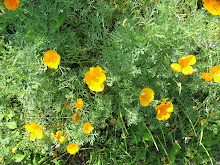The wait is over. Now you have more tomatoes than you can handle. They are rotting on your windowsills and in your refrigerator. Friends and acquaintances run away when they see you approach with a bulging bag. You've resorted to the anonymous act of leaving them on a table in the staff lunchroom or beside the road with a sign that reads, "Take me, please!" What a shame to reach that point, after all of the labor that went towards fruition. How can we ensure that no tomatoes go to waste?
Actually, that's not my predicament this year. I've only grown a few plants with mixed results, with a staggered harvest bearing enough for sandwiches and salads, but not enough for my favorite salsa recipe from the
Horn of the Moon cookbook.
More fortunate gardeners can make tomato sauce. Below is an easy recipe that my mom uses. She said, "I found this recipe in the [New York] Times years ago and it was great to be liberated from the tedious task of dousing the tomatoes in boiling water to peel them."
Thick Tomato Sauce
1 large onion
4 tablespoons olive oil
2 lbs. fresh tomatoes
1 tablespoon minced garlic
1/4 cup minced fresh basil
1 tablespoon minced fresh parsley
1/2 teaspoon sugar
1 teaspoon salt
fresh ground black pepper to taste
1. Peel the onion and cut in half, then slice very thinly.
2. Heat olive oil in cast iron skillet. Add the onion and cook until soft but not brown, about 10 minutes.
3. Do not peel the tomatoes; simply cut them into small pieces, removing stem, sockets, and blemishes.
4. Add tomatoes, garlic, basil, parsley, sugar, salt, and pepper to the onions. Cook over low to medium heat for 30 minutes or until the mixture is thick.
5. Puree in a food mill or food processor.
She freezes the sauce in plastic cups, removes the molds and keeps the sauce in freezer bags, and thaws out the cups as she needs them.
If I can't escape those tomato donors, I now have one more idea in my repertoire.









